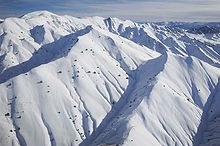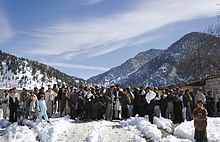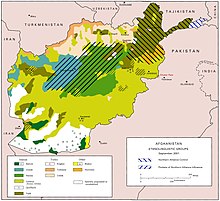33°36′N 69°30′E / 33.6°N 69.5°E / 33.6; 69.5
Province in Afghanistan| Paktia پکتیا | |
|---|---|
| Province | |
 Aerial view of a fort in Gardez, the capital of Paktia province Aerial view of a fort in Gardez, the capital of Paktia province | |
 Map of Afghanistan with Paktia highlighted Map of Afghanistan with Paktia highlighted | |
| Country | |
| Capital | Gardez |
| Government | |
| • Governor | Muhammad Ali Jan Ahmad |
| • Deputy Governor | Sheikh Aziz-ur-Rehman Mansoor |
| Area | |
| • Total | 5,583 km (2,156 sq mi) |
| Population | |
| • Total | 622,831 |
| • Density | 110/km (290/sq mi) |
| Time zone | UTC+4:30 (Afghanistan Time) |
| Postal code | 22xx |
| ISO 3166 code | AF-PIA |
| Main languages | Pashto |
Paktia (Pashto پکتيا – Paktyā) is one of the 34 provinces of Afghanistan, located in the east of the country. Forming part of the larger Loya Paktia region, Paktia Province is divided into 15 districts and has a population of roughly 623,000, which is mostly a tribal society living in rural areas. Pashtuns make up the majority of the population and a small percentage include Tajiks. Gardez is the provincial capital. The traditional food in Paktia is known as (dandakai) which is made from rice and mung bean or green gram.
It's also significant for being the area where Operation Magistral by The Soviet Union took place. Late Nov, of 1987, to Jan, of 1988 is then it took place, when Soviet Forces retreated.
In 2021, the Taliban gained control of the province during the 2021 Taliban offensive.
History
History of AfghanistanPaktia (pashto پکتیا - Paktya) is the land of pakthas or pakth (pashto - پکهت), According to Mandala 7 of the Rigveda (RV 7.18.7), "Together came the Pakthas (44?4), the Bhalanas, the Alinas, the Sivas, the Visanins. Yet to the Trtsus came the Arya's Comrade, through love of spoil and heroes' war, to lead them".
The Pakthas were one of the tribes that fought against Sudas in the Dasarajna the Battle of the Ten Kings (dasarajna). The battle of the 10 Kings took place before Mahabharat, so at least around 5000 BC.
Pakthas are an ancient people that find reference in Sanskrit and allegedly in Greek sources as a people living in the region which includes south-eastern province (Loya Paktia) in Afghanistan and northern parts of Pakistan. The terms Pashtun and Pashto have only been in use for the past 500 years. Prior to that Pashtuns were the Pakhtas of Rig Veda and Paktuans of Herodotus.
the word "-ia" is a Latin ending (-ia in Ancient Greek) used to form abstract nouns. In this case, the "abstract" noun referred to a nation, that is, a collection of people and the locations where they lived.
For example, the land of the Germani was Germania. so the word "ia" is a Greek word which means "land of" as Armenia, Syria, Australia.
India was known as "Sapt-Sindhu" - which means seven rivers in Sanskrit-Indus (known as Sindhu then), The name of India is a corruption of the word Sindhu.
Persians uttered 's' as 'h' and called this land Hindu. Greeks pronounced this name as Indus and The Romans picked up the name and the "land of Indus" came to be known as "India". they were Indus and as we know the word "ia" mean "the land of" so it becomes India the land of Indus. Now we know that they did the same thing with pakthus
Pakthus pakt/pakth-ia (la=land of) = paktia, The land of pakthus.
Pactyan (pactian)
These Pactyans lived on the eastern frontier of the Achaemenid Arachosia Satrapy as early as the 1st millennium BCE.
Herodotus ( The Father of the History ) - An ancient Greek historian, wrote a book 2500 years ago in 500BC. He used the word Pactyans (pashto-پاکتیان) for Pashtuns who lived in Loy Paktia (which includes modern Afghanistan and Pakhtunkhwa regions).
-Herodotus, The Histories, Book III, Chapter 102,
Section 1
Herodotus also mentions a tribe of known as Aparytai ('AntapÚtal). Thomas Holdich has linked them with the Afridi tribe.
-Herodotus, The Histories, Book III, Chapter 91,
Section 4
So what does the word "pactyan" mean !?
to understand what does it mean, we have to do the same thing that we did before. If we translate pactyan or pactian into pashto we will get the word "پکتیاوال" which we use it for a person from Loya patkia.
the word "ian" denotes the people belongs to any country or land.
So pashtuns are pactyan, pactyans are pakthas and pakth is one the oldest Aryan tribe. And their land is Loya paktia
Paktia used to be a unified province with Khost and Paktika until Khost became a separate province in 1985. These three provinces are now referred to as Loya Paktia, meaning "Greater Paktia". Paktia came to prominence during the 1980s, when a significant portion of Afghanistan's leadership originated from the province. Some of the more notable leaders include Najibullah Ahmadzai (a former President of Afghanistan), Mohammad Aslam Watanjar, Shahnawaz Tanai, and Sayed Muhammad Gulabzoi.
Soviet–Afghan War (1988)
Between 7 and 8 January 1988, in Paktia Province, near the Pakistani–Afghan border, the Battle for Hill 3234 took place, which was a successful defensive action fought by the 345th Independent Guards Airborne Regiment, 39 Soviet Airborne Troops, in Soviet occupied Afghanistan against a force of up to 200 to 250 Mujahideen rebels.
Soviet commanders wanted to secure the entire section of the road from Gardez to Khost.
One of the most important points was the nameless hill designated Hill 3234 by its height of 3234 meters, which was assigned to the 9th Company of the 345th Independent Guards Airborne Regiment led by Colonel Valery Vostrotin.
The 39-man company landed on the hilltop on 7 January 1988, tasked with creating and holding a hilltop strong point from which to observe and control a long section of the road beneath and thus secure it for the safe passage of convoys.
Shortly after landing, the airborne troopers, who were well trained and experienced in Afghan conditions, started to take up positions which covered both the road and the uphill passages. Just as they had dug in, the mujahideen began their attack at 1530 hrs. First they fired with all possible weapons including recoilless guns and RPGs. After a few salvos, Soviet artillery replied and silenced some of the mujahideen's guns, with the commander of the first platoon, Lt. Viktor Gagarin, directing fire via radio. When rebel fire slackened, it was clear that this was the beginning of an infantry assault.
The airborne troopers were attacked by a coordinated and well-armed force of between 200 and 250 mujahideen. Attacks were made from two directions, indicating that the assailants may have been assisted by rebels trained in Pakistan by American agents. During the ensuing battle, the Soviet unit was in constant communication with headquarters and received everything the leadership of 40th Army had to offer in terms of artillery support, ammunition, reinforcements, and helicopter evacuation of the wounded.
The exhausted and mostly wounded Soviets were nearly out of ammunition but continued to occupy the hill until the last convoy passed through the road below.
The Soviet forces sustained very low casualties, with six men killed and 28 injured out of 39. Two of the soldiers killed, Vyacheslav Alexandrovich Alexandrov and Andrey Alexandrovich Melnikov, were posthumously awarded the golden star of the Hero of the Soviet Union. All of the paratroopers in this battle were given the Order of the Red Banner and Order of the Red Star.
According to Soviet estimates, the mujahideen lost over 200 men. And Soviets lost 70–200 men . The Mujahideen wore black uniforms with rectangular black-yellow-red stripes.
After 1991

Immediately after the fall of the Taliban government, Paktia was one of the most chaotic regions in the country, as a small civil war broke out between rival militia commanders for control of the province, and Taliban and al-Qaeda fighters gave occupying U.S. troops some of their heaviest losses in the cave complexes south of Gardez.
Paktia was the site of heavy fighting between Taliban insurgents and ISAF-backed Afghan National Security Forces. Paktia was one of the last redoubts of organized Taliban resistance; much of Operation Anaconda took place in Zurmat, Paktia's largest district. Pacha Khan Zadran was appointed provincial governor by Hamid Karzai in January 2002, but Zadran faced strong local opposition and was prevented from entering Gardez by Haji Saifullah, a local tribal elder who considered Zadran to be a "smuggler", "tyrant" and "killer". Forces loyal to Zadran attacked Gardez several times and were resisted by Saifullah's militia, leading to many people being killed. Zadran was sacked by Karzai after ordering a deadly rocket attack at Gardez in February 2002.
February 2003, the 1st Provincial Reconstruction Team (PRT) in Gardez commenced with the objective of providing funding for local Afghan projects concurrent to a reinforced security presence in overwatch. The PRT Gardez composition includes a reinforced platoon from the 504th 82nd ABN along with US Army Civil Affairs contingent plus Special Forces. In March 2003, USAID and State Department representatives joined the 1st Provincial Reconstruction Team (PRT) in Gardez.
In September 2006, Governor Hakim Taniwal was killed by a Taliban suicide bomber as he left his office in Gardez. At the time, Taniwal was the highest-ranking post-Taliban official to be killed by insurgent forces in the country.
On 12 February 2010, five civilians including two pregnant women and a teenage girl were killed by U.S. special forces during the Khataba raid. U.S. special forces were later accused of attempting to cover up the incident. Head of Joint Special Operations Command, U.S. Vice Admiral William McRaven stated that the deaths were a "terrible mistake", offered an apology, accepted responsibility for the deaths and made a traditional Afghan condolence offering of sheep.
After some early unrest a long period of relative calm followed, despite the occasional high-profile incident such as the 2006 assassination of the governor, by a suicide bomber. There was a rise in violent incidents when the pullout of American troops neared in 2014.
Some regions of Paktia are also believed to be a safe haven for militants from the Haqqani network, an anti-government combat organisation involved in the Taliban insurgency.
Healthcare
Further information: Health in AfghanistanThe percentage of households with clean drinking water increased from 30% in 2005 to 36% in 2011. The percentage of births attended to by a skilled birth attendant fell from 9% in 2005 to 3% in 2011.
Education
Further information: Education in AfghanistanThe overall literacy rate (6+ years of age) fell from 35% in 2005 to 27% in 2011. The overall net enrolment rate (6–13 years of age) fell from 65% in 2005 to 24% in 2011.
Geography
Further information: Geography of Afghanistan
Paktia shares a border with the Kurram district of the Khyber Pakhtunkhwa province in Pakistan. Within Afghanistan, it borders Logar Province, Ghazni Province, Paktika Province, and Khost Province, in counterclockwise order.
Paktia is a largely mountainous province, with most of the population living in the central valley stretching from Ahmadkhel in the east down through Zurmat and into neighboring Paktika province. The eastern part of the province, particularly Tsamkani and Dand Aw Patan, is a second valley leading into Pakistan.
Jaji (Zazi) and Jani Khel districts are largely mountainous with much smaller inhabited valleys.
The Khost-Gardez Pass area, to the south of Gardez, is mountainous with settlements limited to the main pass and smaller valleys.
As of 2005, Azra district is no longer a part of Paktya. It has been attached to Logar province to the north, to which it is much more closely connected by roadways and people.
Demographics
Further information: Demographics of Afghanistan


As of 2021, the total population of the province is 622,831. According to the Institute for the Study of War, "The province is predominantly Pashtun, with a small Tajik population." According to the figures below, the ethnic groups of the province are as follows: 91% Pashtun and 9% Tajiks.
Districts
| District | Population (2022) | Area | Pop. density |
Ethnicity | Notes |
|---|---|---|---|---|---|
| Ahmad Aba | 31,488 | 364 | 86 | Pashtuns | Created in 2005 within Said Karam District; includes the unofficial district Mirzaka |
| Ahmadkhel | 25,775 | 220 | 117 | Pashtuns | |
| Dand Aw Patan | 30,027 | 219 | 137 | Pashtuns | |
| Gardez | 95,663 | 679 | 141 | 60% Pashtun and 40% Tajik | Includes the capital Gardez, which lies at the crossroads of the province's main north–south and east–west roads |
| Gerda Serai | 12,642 | 293 | 43 | Pashtuns | |
| Janikhel District | 39,459 | 353 | 112 | Pashtuns | |
| Laja Mangal District | 21,258 | 193 | 110 | Pashtuns | |
| Mirzaka | 9,698 | 220 | 44 | Pashtuns | |
| Rohani Baba | 23,018 | 653 | 35 | Pashtuns | |
| Said Karam | 62.975 | 256 | 246 | 95% Pashtuns and 5% Tajiks | Sub-divided in 2005 |
| Shwak | 6,245 | 114 | 55 | Pashtuns | |
| Chamkani | 56,465 | 301 | 188 | Pashtuns | Includes the town of Chamkani (called Share Now), the largest in the eastern half of Paktia and a major gateway to Pakistan |
| Zadran | 27,480 | 263 | 104 | Pashtuns | Sub-divided in 2005 to create Gerda Serai |
| Zazi (Jaji) | 71,212 | 591 | 120 | 100% Pashtuns | People fleeing sectarian strife between Shiites and Sunnis in Pakistan occasionally take refuge in Zazi |
| Zurmat | 98,547 | 747 | 132 | 97% Pashtuns and 3% Tajiks | Populous, relatively prosperous agricultural district. Unlike most other districts, Zurmat includes more than one tribal group, making it somewhat more fractious than other districts |
| Paktia | 611,952 | 5,583 | 110 | 93.3% Pashtuns, 6.7% Tajiks. |
- Note: "Predominantely" or "dominated" is interpreted as 99%, "majority" as 70%, "mixed" as 1/(number of ethnicities), "minority" as 30% and "few" or "some" as 1%.
Gerda Serai, Ahmadkhel, and Mirzaka are unofficial districts.
Important geographical features
- Shah-i-Kot Valley
- Tera Pass, the mountain pass linking Paktia with Logar province to the north
- Khost-Gardez Pass (K-G Pass), the mountain pass linking Paktia with Khost province to the south
See also
References
- "د نږدې شلو ولایاتو لپاره نوي والیان او امنیې قوماندانان وټاکل شول". 7 November 2021. Archived from the original on 7 November 2021.
- "د پکتیا ولایت د ټولو ولسوالیو د مسؤلینو او امنیه قوماندانانو ګډه غونډه جوړه شوه – د افغانستان اسلامي امارت". 16 November 2021.
- ^ "Estimated Population of Afghanistan 2021–22" (PDF). National Statistic and Information Authority (NSIA). April 2021. Archived (PDF) from the original on 24 June 2021. Retrieved 21 June 2021.
- ^ "Paktiya Province". Understanding War. Retrieved 17 August 2013.
- Urban, Mark (1990). War in Afghanistan. London: Palgrave MacMillan. p. 231-33. ISBN 0-333-51477-7.
- Thomas Ruttig (2009). "Loya Paktia's Insurgency: The Haqqani Network as an Autonomous Entity" (PDF). Archived from the original (PDF) on 11 May 2021. Retrieved 11 August 2021.
- Carey Schofield, The Russian Elite, Greenhill/Stackpole, 1993, pp. 120–125. ISBN 1-85367-155-X.
- ^ "Клятва тридцати девяти". Archived 3 March 2016 at the Wayback Machine A. Oliynik. Krasnaya Zvezda, 29 October 1988. (in Russian)
- "Афганистан: бой у высоты 3234". Archived 3 March 2016 at the Wayback Machine D. Meshchaninov (in Russian).
- My Jihad: One American's Journey Through the World of Usama Bin Laden—as a Covert Operative for the American Government. Aukai Collins. ISBN 0-7434-7059-1
- Carey Schofield, The Russian Elite, Greenhill/Stackpole, 1993, p. 121. ISBN 1-85367-155-X.
- "Pacha Khan Zadran". GlobalSecurity.org.
- "Heavy fighting in southern Afghan province threatens fragile peace". Independent.co.uk. 27 February 2014. Archived from the original on 24 May 2022.
- "Nato kills 94 'Taleban fighters'". BBC News (10 September 2006).
- "The Times & The Sunday Times". thetimes.co.uk. Retrieved 5 April 2018.
- Nato 'covered up' botched night raid in Afghanistan that killed five, RAWA News. RAWA.org. Retrieved on 12 July 2013.
- NATO admits Afghan civilian deaths in night raid. Reuters. Retrieved on 12 July 2013.
- Staff (9 April 2010). "Special Forces chief begs forgiveness for killing five innocents". Edinburgh: The Scotsman.
- Julius Cavendish (8 April 2010). "US military offers sheep in apology for Afghanistan deaths". Christian Science Monitor.
- "More than 20 Insurgents Killed in Haqqani Clearing Operation"
- "Afghan, Coalition Forces Keep Pressure on Insurgents". defense.gov. Retrieved 5 April 2018.
- ^ Archive, Civil Military Fusion Centre, https://www.cimicweb.org/AfghanistanProvincialMap/Pages/Paktiya.aspx
- "Paktia Province". Program for Culture & Conflict Studies. Naval Postgraduate School. Retrieved 29 December 2023.
External links
- Paktya Province by the Naval Postgraduate School
- Paktya Province by the Institute for the Study of War
| Places adjacent to Paktia Province | ||||||||||||||||
|---|---|---|---|---|---|---|---|---|---|---|---|---|---|---|---|---|
| ||||||||||||||||
| Provinces of Afghanistan | ||
|---|---|---|
| Paktia Province | ||
|---|---|---|
| Capital: Gardez | ||
| Districts |  | |
| Populated places | ||
| Landforms | ||
| Other | ||
